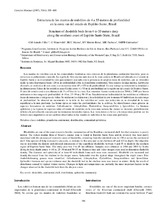Structure of rhodolith beds from 4 to 55 meters deep along the southern coast of Espírito Santo State, Brazil

View/
Date
2007Author
Amado-Filho, Gilberto M.
Maneveldt, Gavin
Manso, R.C.C.
Marins-Rosa, B.V.
Pacheco, M.R.
Guimarães, S.M.P.B.
Metadata
Show full item recordAbstract
Rhodoliths are one of the most extensive benthic communities of the Brazilian continental shelf, but their structure is poorly
known. The richest marine flora of Brazil’s coastal zone is found in Espírito Santo State and its diversity has been partly
associated with the presence of extensive areas of rhodoliths, extending from the intertidal zone to 120 m across the continental
shelf. One species of kelp, Laminaria abyssalis, is endemic to this area and occurs between 45 and 120 m depth. Our objective
was to determine the density and physical dimensions of the superficial rhodoliths between 4 and 55 m depth in the southern
region of Espírito Santo State. The study area was 3 to 45 km offshore. Samples were obtained in 2004 and 2005 by Scuba
diving in three depth zones: 4–18 m, 25–30 m and 50–55 m. Transect lines and video images were used to determine rhodolith
density. The diameter and sphericity of at least 60 individuals from each zone were measured. Rhodolith size increased and
density decreased from the shallow to the deeper zones. Spheroidal was the typical shape throughout the depth zones. Five
rhodolith-forming genera were identified: Lithothamnion, Lithophyllum, Hydrolithon, Neogoniolithon and Sporolithon.
Epibenthic biomass and species richness over the rhodolith bed in the shallow zone was lowest in winter, likely the result of
disturbance caused by typical winter storms. Changes in light and temperature are probably the most important factors in the
changes observed in the rhodolith beds from the deepest zones.
